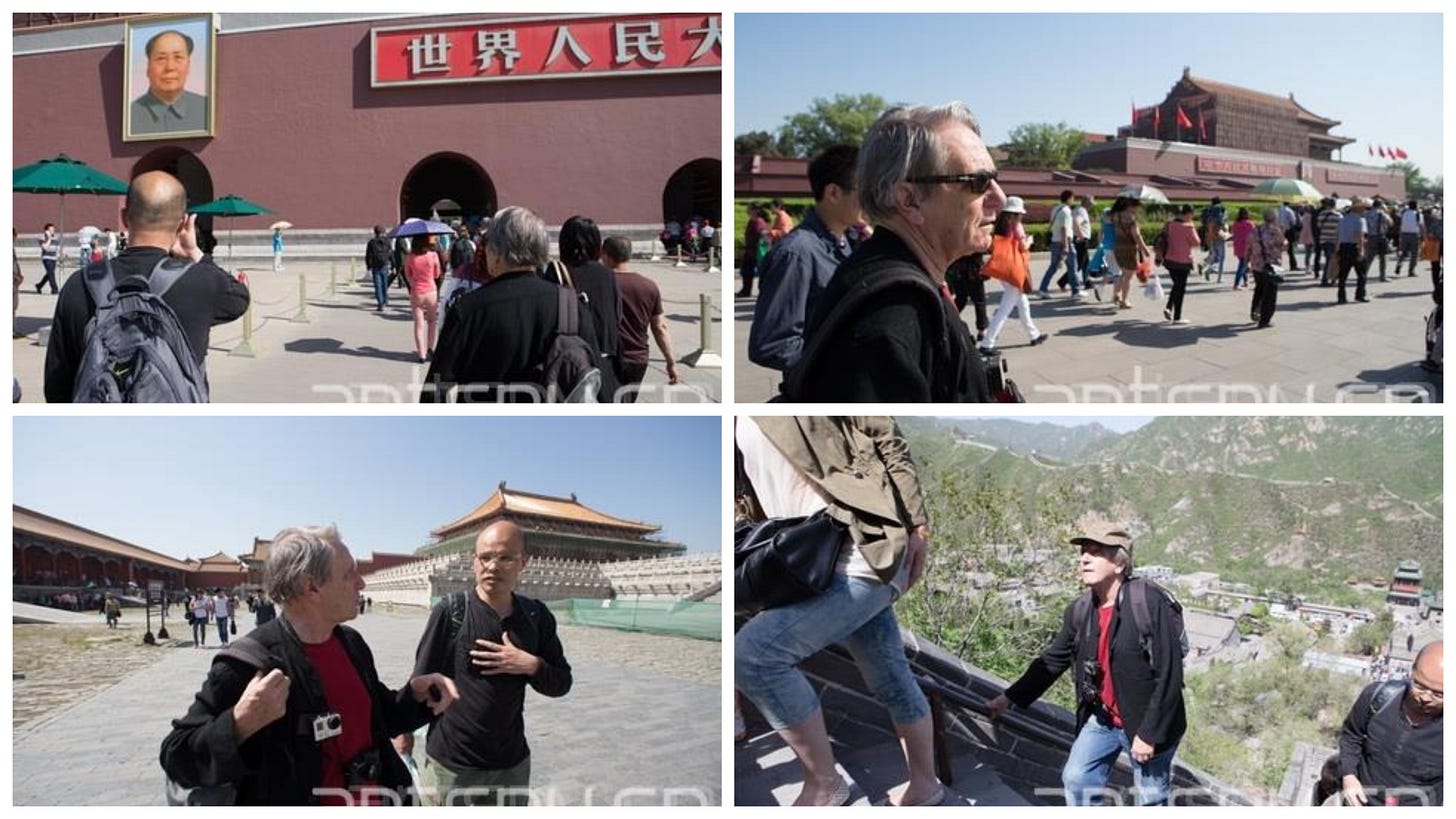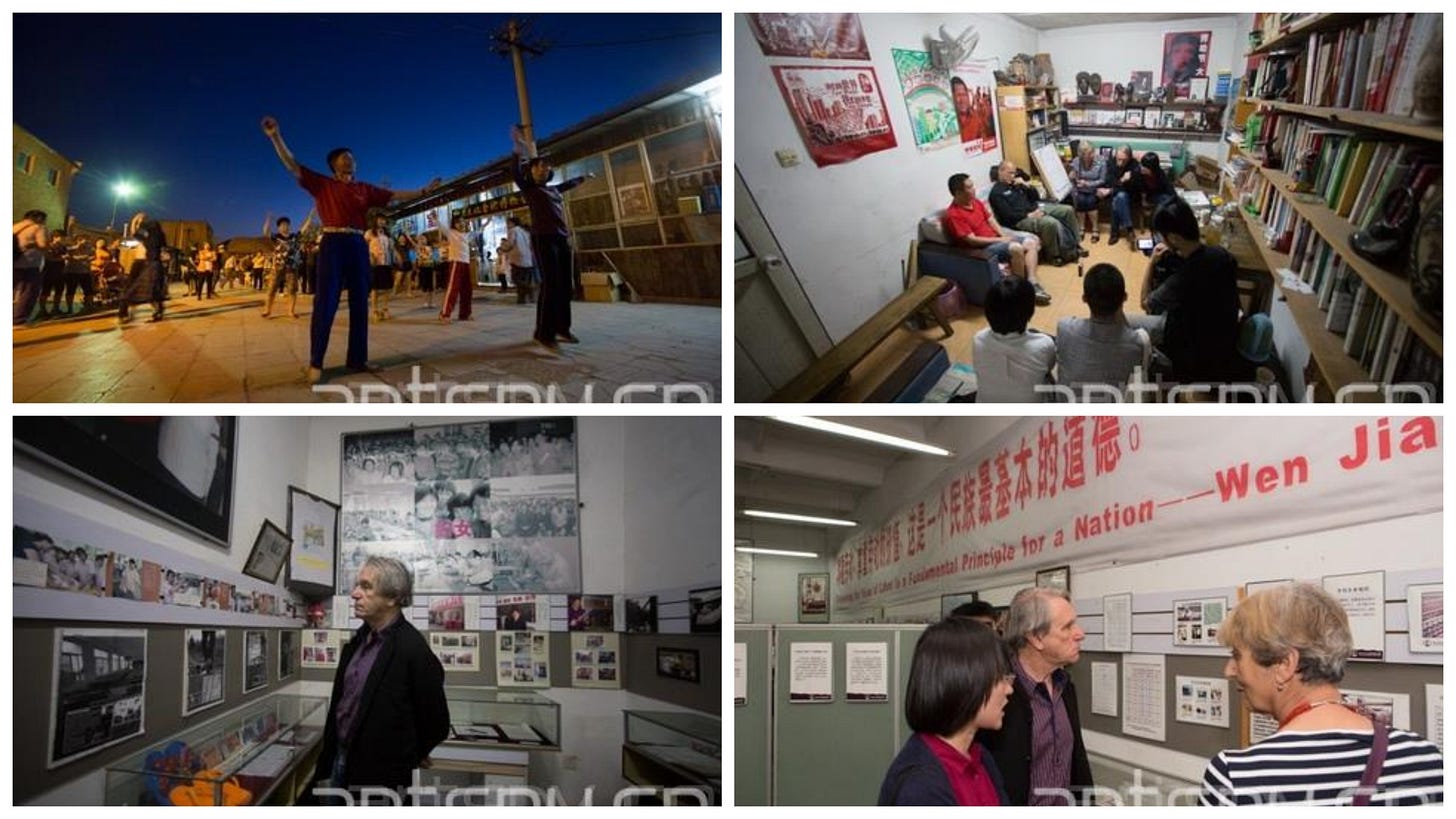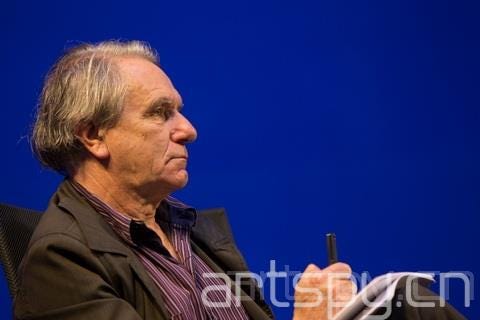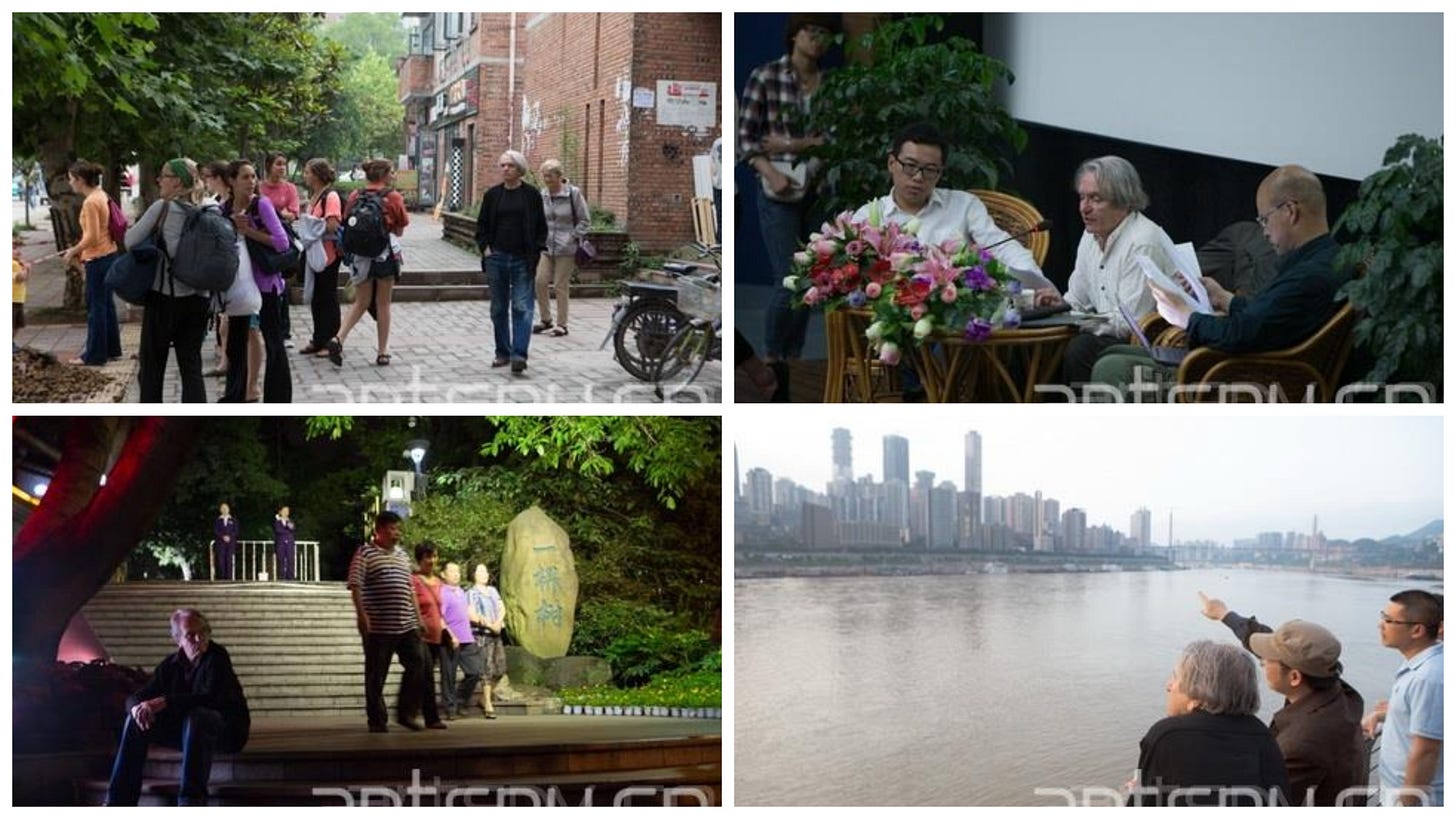Rancière is coming [part two: this is a translation of Artspy's account of the second half of Jacques Rancière's visit to China in 2013]
[I am going to continue translating Tao Fangcheng’s account for Artspy of Jacques Rancière's visit to China twelve and a half years ago. Dispatches from the first five days appeared here. Forgive the errors. I haven’t read enough of Rancière's work not to fumble the language. Forgive the looseness of my translation. ▭ I hope, even if you are not familiar with Rancière or the Chinese contemporary art world circa 2013, this could still be interesting. Tao Fangcheng leaves unattributed a remark made by a participant during the first half of the tour, while they are touring Yiwu: “Here, we have the capitalist reality: the factory of the world and the marketplace of the world. But the source of theory is not in China." The phrasing is too awkward in my translation. It could be: under global capitalism, everything is made in China, except for theory. Tao Fangcheng observes that this is about to change. In her account, Rancière is usually silent, or he speaks in generalities. He struggles to update his theoretical positions for Chinese reality. His theory is applicable, but it must be applied by local thinkers. Rancière’s use is as a pawn in domestic battles of which he must have been completely unaware of. That’s my reading of the situation, at least.]
Jacques Rancière's tour of China, day six: Beijing
On his first day in Beijing, Rancière made sure he was free of any academic activities, so that he could go to see the Forbidden City and the Great Wall. Lu Xinghua was disappointed. Why should a leftist have any interest in such places? A photographer that accompanied them on the outings said that Rancière and his wife enjoyed themselves immensely. When they returned to the hotel at six o'clock, the couple was in good spirits, and praised Beijing's sun and clear, blue skies. No matter how much significance has been attached to Rancière's junket, he looked at that moment as relaxed as any other tourist in the city.
The visit to Picun this evening was a last-minute decision. The small village between the Fifth and Sixth Ring Roads is home to thousands of migrant workers, who are known for their unique forms of self-government. Projects over the past decade by several young artists and writers, themselves migrants to Beijing, have resulted in an independent economic system (the second-hand shops), educational system (a university for workers), exhibition system (a migrant labor museum and theater), and a culture brand (the yearly arts festivals for migrant workers). "I believe changing the world begins gradually, starting in small places like this," Sun Heng said, standing in his modest office and reception. On his bookshelves were biographies of revolutionary leaders and records of global socialist movements, but also documents related to labor rights and material on migrant workers. The goal of his group is use culture to raise the consciousness and strengthen the sense of identity of workers. In the courtyard, a crowd gathered around a screen showing a James Bond movie. People were reading in the library. Children played in the yard, alongside a group of women doing aerobics. On the wall of the museum was a quote from Wen Jiabao: "Respect for labor is a fundamental principle for a nation." It gave the impression of a well-functioning community.
The lives of those in Picun certainly seemed to correspond in some ways with those of the workers in Proletarian Nights: after work, they wrote poetry, sang, and put on shows (they even had a Spring Festival gala!); in Picun, it was not atomized individuals taking their leisure, however, but an organized, regulated social group with clear goals. Picking up a remark that Lu Xinghua had made about the similarities between the work of Picun's organizers and that of contemporary artists, Sun Heng said this: "I don't think what we're doing here is in any way inferior to what the artists at 798 are up to. Aren't we doing the same thing? The difference between us and the artists is that our work is connected to the lives of normal people." Lu Xinghua was slightly skeptical of this extension of his point, but that merely energized the arguments of Sun Heng and the others. Rancière spent most of the hour-long discussion listening, saying little. In the end, his opinion was basically positive. Some criticism had been made of the choice of films to show the workers, but Rancière said that the use of mainstream culture should not be considered problematic. He approved of the publishing enterprise and the activities organized by the founders. Whether or not he was being sincere or simply courteous was unimportant. Rancière took the same approach to the scenes along his tour that he did with works of art in his writing, never passing judgement, but collecting material to support his theory. Picun did not need his affirmation or critique; it was the product of internal reflection. In this respect, there might be a lesson from Chinese contemporary art, which boomed in the underground in the 1980s and 1990s but went slack in the golden days of the 2000s.
Jacques Rancière's tour of China: Reflections on Beijing
Rancière’s two events in Beijing were held at the UCCA Center for Contemporary Art and the Central Academy of Fine Arts. The title of the UCCA lecture was "What is the Time of Contemporary Art?" and was fairly conventional in format. When the floor was opened to questions, the artist Wang Jianwei stood and charged Rancière with using mediocre works of art to support his conclusion. These lesser works did not support the distribution of the sensible. Rancière had to once again explain that he did not select examples to pass judgement on their quality. The artist and the philosopher stood their ground. The CAFA event was planned as a dialogue between Rancière and the Chinese art world. Rancière was joined by Lu Xinghua, Wang Jianwei, Wu Xiaojun, Tie Ying, Yang Beichen, with He Chi as the moderator. But could this group really be taken as representatives of the Chinese art world? Were they a cross-section or an assemblage? The title for the event—"Aesthetic Regime of Art for Now"—was vague and forgettable.1 The discussion shambled from time in contemporary art, to Occupy Wall Street, to consensus and dissensus, to the Cultural Revolution, with digressions in between, followed by questions from the audience.2 Lu Xinghua's freeform style of translation made it difficult to establish whether we should analyze the event as theory or performance. If it was a performance, then Rancière was certainly not the main attraction. Later that night at xian bar, someone commented that even if Rancière might never grasp contemporary Chinese art, he had at least gotten a glimpse of how the scene conducted itself.
Rancière began a discussion of consensus by comparing contemporary and modern art, with the examples of Vladimir Tatlin's Monument to the Third International and Ai Weiwei's parody.3 Once again, he proposed that art should not be bound by a specified form; contemporary art is art that defies formal differentiation. But contemporary art has in it different ambitions than Tatlin had for his Monument: contemporary art is no longer concerned with belief or unbelief, but with the distribution of times and spaces. Contemporary art inherits architectural fusion of the arts from the avant-garde of the 1920s—that is, the mixture of arts, whether film, photography, sound, installation, etc.4 However, this architecture cannot construct new forms or temporalities, and it cannot secure or represent life. Rather, it is intended to be moved through, or to be viewed, in a predetermined artistic space and time. It builds a historical space, where art retains and also challenges its past and our present.
"Consensus" was prominent in the thinking of twentieth-century Europe. This was true in economics, governance, and other realms. Consensus came from what seemed the historical necessity of agreeing that there was only one time, and one reality, and one method of temporal progression. "Dissensus," then, comes from the invention of new forms for presenting things, new modes of relation between these forms, the disordering of time, and introducing many times in the same time. Rancière spoke about the idea of fiction. Fiction is not fantasy; fiction does not oppose reality. Fiction becomes a structure to link different modes of representation and modes of intelligibility. The opposition is not between reality and fiction, but between different senses of reality.
Rancière spoke next about Chen Chieh-jen's Factory, in which different times and ways of representing time are fused together: it starts with an abandoned garment factory filled with clutter and old machinery, time seeming to stand still. In this space, the artist has stitched together three times: there is the past, represented in two former workers hired to carry out the jobs they once held; there is the time of capital, which is itself a double, represented by the two former workers standing like statues in the plant, and the factory in an old propaganda film, when it was still operating. Rancière said that what he finds interesting is that those different times are represented by different visual forms: the panoramic propaganda film showing the regular operation of the factory; the contrast, with Chen Chieh-jen taking the elements of a narrative feature in depicting the workers, their expressiveness standing out against the backdrop of the abandoned factory. The audience sees a fusion of times, but also a fusion of fictions. Dissensus arises when the past is inserted into—and haunts—the present. It is the dissensus produced in this fusion of times that self-emancipation can begin, Rancière argued.
When the discussion opened to the audience, someone asked about the realistic possibilities of this dissensus. After all, when one steps outside of the gallery, they return to capitalist reality. The process can be repeated, but how is it resolved? After Rancière answered, one of the panelists joked that his response was not dissimilar from what our government says, summarizing it this way: "Nobody’s going to help you figure things out, so it’s up to you to figure them out."
Jacques Rancière's tour of China: Shanghai and “The Politics of Documentary”
On the seventeenth [of May], Rancière gave a lecture at the Institute of Visual Arts at Fudan. This was held in the school's Virtual Studio—a deliberate choice, with the blue screen backdrop suggesting virtuality, theater, performance, and the blurring of boundaries. The content of the speech, entitled, "The Politics of Documentary," held no surprises, however, and the talk and discussion proceeded smoothly. The informal discussion session the next day at Tongji University was quite unlike previous events on the tour. For the first time, there was no mention of art. Most of the participants were from the philosophy department. It had the casual air of an afternoon seminar, with Rancière discussing his younger years and reading Capital with Althusser, then answering questions on equality, violent revolution, Mao Zedong, and the Cultural Revolution. This led to some self-reflection among those of us preoccupied with the intersection of art and theory. The only way to resolve our doubts seemed to be engaging in long-term introspection, and confronting our own work and opening it up to wider discussion. Even before Rancière’s visit to China ended, we had already begun to look back on it. What did he bring us? What settings had proven the most productive? What sort of effect should we pursue? What would Rancière leave behind when he left? And what could we make of it?
In the film Je veux voir, Catherine Deneuve goes to the Lebanese countryside with local actor Rabih Mroué to see the suffering of a nation in the aftermath of war. In the opening scene, the Lebanese actor searches a field of rubble for the remains of his grandmother's house. She wants to see; he helps her to see. She asks questions; he responds. Their lines of sight diverge. But suffering is still visible. At the end of the film, Deneuve, on her way to an event at the French embassy, seems to be returning to her ordinary context, but actually remains within the extraordinary. The camera pans from the faces of the two actors riding in the car to the seaside, where a crane is dumping bricks from ruined cities into the ocean. Suffering is no longer visible, but it remains perceptible in the movements of the crane. The two actors run out of lines. Mroué's final monologue is not in French. He speaks in his own language about his country, its suffering, and his own feelings.
Rancière played another clip from Pedro Costa's documentary. A black laborer is left alone in his tenement apartment, which will soon be torn down for social housing to be built. The subject, the setting, and the events depicted were real, but through the work of Costa, the subject became an actor and the setting a stage. The subject's actions and expressions seemed performative. There was a collaboration at work between subject and director. Rancière had spoken about the film during his lecture at the Academy of Art, but this time he talked about it in the context of documentary filmmaking. The politics of documentary do not manifest in the depiction of the life of a particular identity or any predetermined concern over suffering, but rather in stimulating and expressing the capacities of those being filmed. He brought up again Godard's inaccurate quip that the epic was for Israelis and the documentary for Palestinians. The suffering of the latter is so complete that it is all that they can describe. Even if they might have seemed like relatively straightforward productions to discriminating cinephiles, it was clear why Rancière raised these two examples: he was returning to his idea of fiction as a structure to unite different times, places, realities, modes of perception, and modes of representation, and to the possibility of dissensus.
When the discussion session began, someone asked whether or not artists too often fell into the trap of aesthetics. He gave the example of Wu Wenguang. In his film, the migrant workers dance, but they must go back to being migrant workers.5 Thatcher, on the other hand, was able to carry out policies that changed the lives of the working class. What should be done about this contradiction? Rancière replied that he was certainly not advocating for the aestheticization of workers. He returned to Costa's film, suggesting it as an example of both parties—director and subject—coming to an agreement, and both getting what they needed. He went on to say that the present, seemingly apocalyptic state of capitalism was not irregular, but down to the nature of the system. The politics he was talking about had little to do with the realities of government policy, but were about escaping the state of affairs into which we are confined.
Another audience member talked about the worker in the film performing his own life, with a nudge from the director. This was the logic of documentary. Now, with social media, everyone can express themselves. Might this present a challenge to Rancière's ideas, or would it be an opportunity to extend them? Rancière replied that these new forms of self-expression, since they cannot defy existing frameworks, can never constitute dissensus, and rather reinforce consensus. When asked how he would go about producing a documentary about China, Rancière said that he thought the country had no unique characteristics, but experienced the same problems as everywhere else. Of course, he added, the temporal orders under which people live, and the ways they perceive them, might differ, so he would be interested in the lives of those groups who exist across multiple temporal orders.
Jacques Rancière's tour of China: Chongqing
His tour half over, Rancière relaxed by the riverside in Chongqing and ate a dinner of fish. As the old professor leaned on the banister, watching the sun set over the Yangtze, the evening breeze tousled his hair. If not for his overenthusiastic hosts breaking in with commentary, he might have sat entranced for a while longer. Rancière listened attentively, now and then nodding. During the trip, he had never protested being dragged here and there. He had never betrayed the slightenest impatience. He made few requests. He never lost his temper. He never put on airs. He didn't fit the image of the "radical philosopher."
Events planned for the Sichuan Fine Arts Institute were relatively simple, with a lecture only scheduled for one evening. As the evening approached, Rancière became uncharacteristically particular about things. Where was the venue? Was the AV equipment working? Could he stop by a day early to check things out? Right up until the moment the lecture began, he was worried that the images would play out of synch with the sound.
At the Academy of Art, Rancière spoke about equality, at UCCA about time, and at Sichuan Fine Arts Institute, the topic was, "Speaking, Acting, and Doing: Between Art and Politics." He began by showing an 1848 satirical illustration from a British conservative paper, mocking the February Revolution. The barricades and workers become in the cartoon nothing more than props and actors. It represents a performance without substance.6 But it points also to the political nature of theater. Rancière brought up Plato and Aristotle again, but skipped talk of the ethical regime (Plato) and the representative regime (Aristotle), sticking to the theme of the speech, and talking about their writings on theater as a way to talk about the relationship between politics and art (aesthetics): both are ways of shaping the common world, but this so-called common world is only a network of relations between the sayable, the visible, and the doable. Politics is conflict over the structural configuration of the common world. If there is a relationship between politics and aesthetics, it is not that aesthetics borrows the techniques of politics, or that aesthetics conveys messages from politics, but that both constitute structures for spaces and times, reconfiguring the distribution of the sensible by defining the relations between the sayable, the visible, and the doable.
This was material that Rancière has often covered in his writing. He offered four examples: a poster by the Stenberg brothers, Vertov's Man with a Movie Camera, photographs by Thomas Demand, and an Alfredo Jaar installation. In the Soviet avant-garde film and the poster for it, Rancière called attention to the demolition of the barriers between word and image, and how both were whipped into a torrent of action. Rancière said that this aesthetic revolution—breaking down the distance between speech, performance, and action, fusing politics and art through the language of movement—is a utopian fantasy long-since expired, but that it remains a helpful point of reference for understanding the relation between artistic forms and politics. Thomas Demand's photographs and the way they extract information from media images through a process of subtraction, and then talked about how Alfredo Jaar's Rwanda projects replace images with words through a process of substitution. These two examples very likely brought knowing smirks from the cognoscenti.
At the close of his talk, Rancière once again emphasized that he was not passing any kind of judgement on the works he had used as examples. This reminder was not really necessary. The art world is packed with clever ignoramuses, who, when confronted by foreign standards, remain on guard, even if they could not offer their own judgements.
If Rancière’s tour of China can be taken as a performance of theory, then we must consider his own words, that the function of performance is not to hide but to reveal. Exposing contradictions creates conflict. If this is true of workers, why shouldn't it hold for intellectuals? It's notable that Rancière spoke in a positive way about the political nature of theater. In the art world, we are used to hearing complaints that art is ruled by socially-prescribed commissions, or that the artist's role has been diminished. Is Rancière naïve, or are we too cynical? That seems like a question worth taking seriously.
[I inserted the official English title for the event. It doesn’t sound so bad, does it? The Chinese title is quite vague. It might be translated, poorly, literally, as “Contemporary Art's Re-Convergence.” I suppose it draws on Rancière’s ideas about consensus.]
[There are accounts of this event online that go into more detail on what was said by whom. The discussion became a chance to press Rancière on concerns unrelated to time and contemporary art.]
[This is Fountain of Light, a small-scale replica of Tatlin's tower, made of glass and steel.]
[Rancière’s talk, given in French, has been translated into Chinese and English. I can’t find the original text. I have drawn in some places here on the English translation published in the China Literary Theory Association’s Theoretical Studies in Literature and Art.]
[Wu Wenguang shot a documentary in 2001 about a production by a Beijing choreographer that featured migrant workers. Perhaps Tao Fangcheng is leaving something out of this exchange. Maybe the audience member did think it was worthwhile to contrast Wu Wenguang and Margaret Thatcher.]
[This begins a lengthy section of my interpretation of Tao Fangcheng’s sketchy paraphrase of Lu Xinghua’s interpretation of Rancière. I’ve done my best to match terminology with Gabriel Rockhill’s translation of The Politics of Aesthetics: The Distribution of the Sensible. There are errors. It’s probably not particularly interesting to most readers, and especially those familiar with Rancière.]







